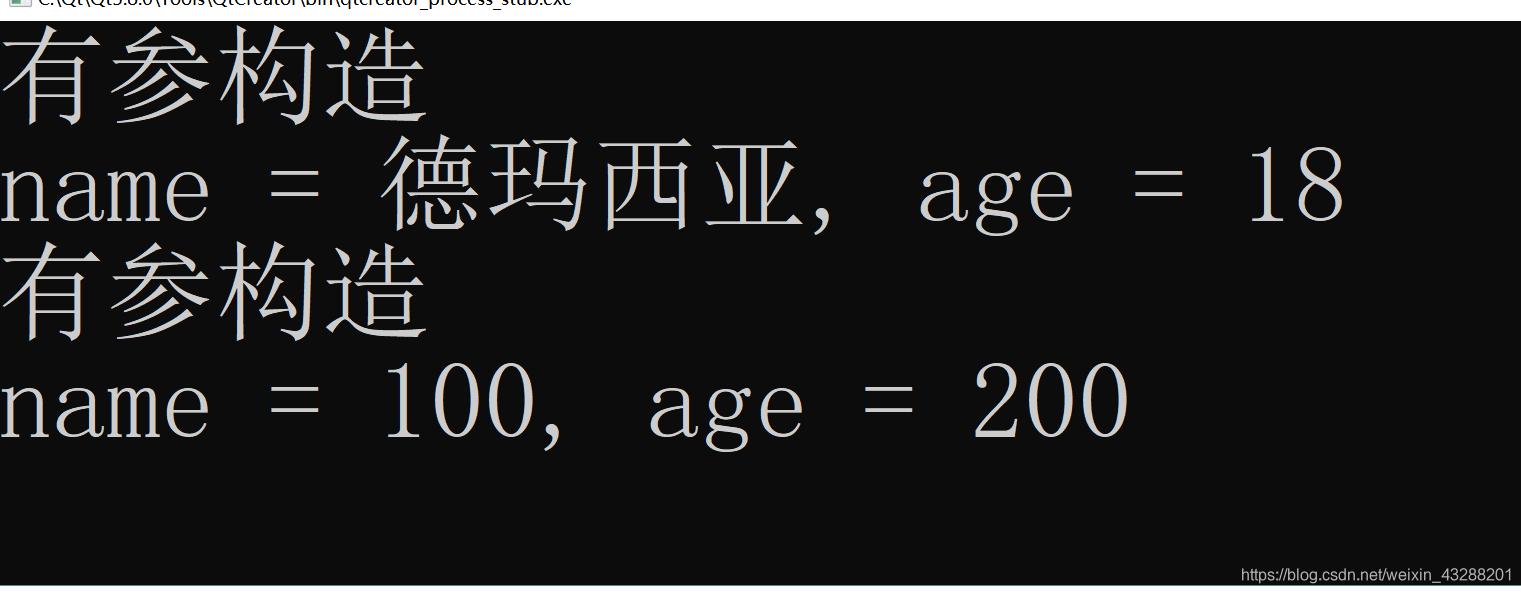9、类模板成员函数 在类外实现
#include <iostream>
#include<string>
using namespace std;
//严格来说;类模板的类型 不是Person 而是Person<T1,T2>
template<class T1,class T2>
class Person{
public:
T1 name;
T2 age;
public:
//类内声明
Person(T1 name, T2 age);
void showPerson(void);
};
//类外定义
template<class T1, class T2>
Person<T1,T2>::Person(T1 name, T2 age)
{
cout<<"有参构造"<<endl;
this->name = name;
this->age = age;
}
template<class T1, class T2>
void Person<T1,T2>::showPerson()
{
cout<<"name = "<<name<<", age = "<<age<<endl;
}
int main(int argc, char *argv[])
{
Person<string,int> ob1("德玛西亚", 18);
ob1.showPerson();
Person<int,int> ob2(100,200);
ob2.showPerson();
return 0;
}
运行结果:

10、类模板头文件 和源文件 分离问题
person.hpp //hpp是包含声明和定义的特殊的头文件
#ifndef PERSON_H
#define PERSON_H
#include <iostream>
#include<string>
using namespace std;
//严格来说;类模板的类型 不是Person 而是Person<T1,T2>
template<class T1,class T2>
class Person{
public:
T1 name;
T2 age;
public:
//类内声明
Person(T1 name, T2 age);
void showPerson(void);
};
//类外定义
template<class T1, class T2>
Person<T1,T2>::Person(T1 name, T2 age)
{
cout<<"有参构造"<<endl;
this->name = name;
this->age = age;
}
template<class T1, class T2>
void Person<T1,T2>::showPerson()
{
cout<<"name = "<<name<<", age = "<<age<<endl;
}
#endif // PERSON_H
main.cpp
#include <iostream>
#include<string>
//include标准是包含头文件 基本上不会包含.cpp
//#include"person.cpp"
#include"person.hpp"
using namespace std;
int main(int argc, char *argv[])
{
//类模板 会经过两次编译
//第一次 类模板 本身编译,第二次编译 是类模板的成员调用的时候
//c++/c 独立文件编译
//如果 类模板的.cpp和.h分文件 出错的原因 在第二次编译
//建议.cpp和.h放在一次
Person<string,int> ob1("德玛西亚", 18);
ob1.showPerson();
return 0;
}
运行结果:

11、类模板 与 友元(了解)
#include <iostream>
#include<string>
using namespace std;
//person类向前声明
template<class T1,class T2> class Person;
//提前声明函数模板 告诉编译器printPerson02函数模板是存在
template<class T1,class T2> void printPerson02(Person<T1,T2> &ob);
template<class T1,class T2>
class Person{
private:
T1 name;
T2 age;
public:
Person(T1 name, T2 age);
//1、友元函数在类中定义(友元不属于该类成员函数)
friend void printPerson01(Person<T1,T2> &ob)
{
cout<<"name = "<<ob.name<<" ,age = "<<ob.age<<endl;
}
//2、友元函数在类外定义 必须告诉编译器 该友元函数是模板函数
friend void printPerson02<>(Person<T1,T2> &ob);
};
//函数模板
template<class T1,class T2>
void printPerson02(Person<T1,T2> &ob)
{
cout<<"name = "<<ob.name<<" ,age = "<<ob.age<<endl;
}
template<class T1,class T2>
Person<T1,T2>::Person(T1 name, T2 age)
{
this->name = name;
this->age = age;
}
int main(int argc, char *argv[])
{
Person<string,int> ob("德玛",18);
//通过友元 访问类模板中的数据
printPerson01(ob);
printPerson02(ob);
return 0;
}
运行结果:

12、类模板的综合案例
myarray.hpp
#ifndef MYARRAY_HPP
#define MYARRAY_HPP
#include<iostream>
using namespace std;
template<class T>
class MyArray{
private:
T *addr;
int capacity;
int size;
public:
MyArray(int capacity);
MyArray(const MyArray &ob);
~MyArray();
//尾插法
void push_back(const T &val);
//遍历数组
void printArray(void);
};
#endif // MYARRAY_HPP
template<class T>
MyArray<T>::MyArray(int capacity)
{
//对于自定义数据类型 new Person[10]; 数组中的每个元素 都会调用无参构造
this->addr = new T[capacity];
this->capacity = capacity;
this->size = 0;
}
template<class T>
MyArray<T>::MyArray(const MyArray &ob)
{
this->capacity = ob.capacity;
this->addr = new T[this->capacity];
int i=0;
for(i=0;i<ob.size;i++)
{
this->addr[i] = ob.addr[i];
}
this->size = ob.size;
}
template<class T>
MyArray<T>::~MyArray()
{
if(this->addr != NULL)
{
delete [] this->addr;
this->addr =NULL;
}
}
template<class T>
void MyArray<T>::push_back(const T &val)
{
// 数组的实际个数size 不能超过 capacity
if(this->size == this->capacity)
{
cout<<"容器已满"<<endl;
return;
}
this->addr[this->size] = val;
this->size++;
}
template<class T>
void MyArray<T>::printArray()
{
int i=0;
for(i=0;i<this->size;i++)
{
//如果输出的是自定义数据 Person必须重载<<
cout<<this->addr[i]<<" ";
}
cout<<endl;
}
main.cpp
#include <iostream>
#include<string>
#include"myarray.hpp"
using namespace std;
class Person
{
friend ostream& operator<<(ostream &out, const Person &ob);
private:
string name;
int age;
public:
Person()
{
;
}
Person(string name, int age)
{
this->name = name;
this->age = age;
}
};
ostream& operator<<(ostream &out, const Person &ob)
{
out<<"name = "<<ob.name<<", age = "<<ob.age<<endl;
return out;
}
int main(int argc, char *argv[])
{
MyArray<char> ob(10);
ob.push_back('a');
ob.push_back('b');
ob.push_back('c');
ob.push_back('d');
ob.printArray();
MyArray<int> ob2(10);
ob2.push_back(10);
ob2.push_back(20);
ob2.push_back(30);
ob2.push_back(40);
ob2.printArray();
//存放自定义 数据
MyArray<Person> ob3(10);
ob3.push_back(Person("德玛",18));
ob3.push_back(Person("风男",19));
ob3.push_back(Person("小法",20));
ob3.push_back(Person("瞎子",21));
ob3.printArray();
return 0;
}
运行结果:

